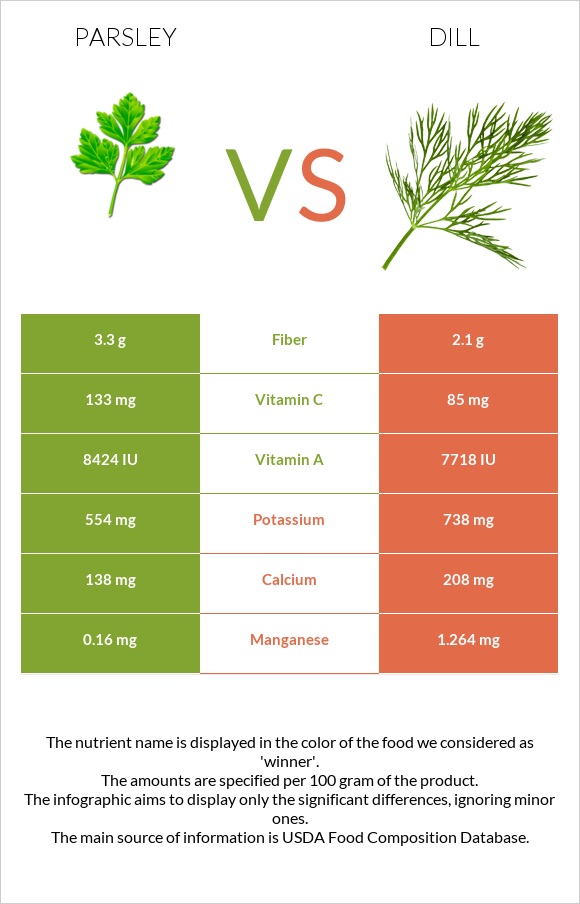Parsley vs. Dill — Health Impact and Nutrition Comparison


Summary
Dill is richer in manganese, calcium, potassium, and B-complex vitamins. However, parsley is higher in vitamin C. Parsley covers the DV of calcium 53% more than dill. Dill is richer in carbs and calories. Parsley provides more dietary fiber.
Introduction
This article compares two herbs - dill (1) and parsley (2)- regarding nutritional differences and health impact.
Actual differences
Parsley and dill are nutritious herbs that differ in taste and appearance. Parsley is a leafy herb, while dill has soft leaves on slender stems. Parsley has a mild, bitter flavor, dill has a sweet, grassy taste.
Both are used as fresh herbs or dried spices. Dill is often paired with potatoes, fish, and yogurt-based sauces.
Nutrition
This section will compare nutrients in 100g amounts of dill and parsley. Check the infographics below for the visual representation of the distribution of nutrients.
Macronutrient Comparison
Contains
more
ProteinProtein
+16.5%
Contains
more
FatsFats
+41.8%
Contains
more
CarbsCarbs
+10.9%
Contains
more
OtherOther
+11.4%
Calories
Dill and parsley are classified as low-calorie foods. Dill contains 43 calories per 100g, while the same amount of parsley provides 36 calories.
Fats
Dill and parsley are plant food products. Hence, they contain neglectable amounts of fats. However, dill is slightly higher in fats than parsley.
Both herbs do not contain any amounts of cholesterol.
Fat Type Comparison
Contains
more
Poly. FatPolyunsaturated fat
+30.5%
Contains
less
Sat. FatSaturated fat
-54.5%
Contains
more
Mono. FatMonounsaturated fat
+171.9%
Carbs
Dill and parsley are low-carb foods. Dill is one gram richer in carbs than parsley.
Parsley contains more fiber than dill: it provides 3.3g of dietary fiber compared to 2.1g in dill. Parsley contains small amounts of sugars, but dill does not contain any quantities.
Protein
Dill and parsley have small amounts of protein. Dill is a little higher in proteins than parsley.
Vitamins
The vitamin content of parsley is higher.
Parsley is higher in vitamins C and A, while dill provides more B-complex vitamins. Parsley contains vitamins K and E. Dill does not provide any amounts of those vitamins.
Dill covers 62% of the DV of vitamin B2.
Vitamin Comparison
Contains
more
Vitamin CVitamin C
+56.5%
Contains
more
Vitamin EVitamin E
+∞%
Contains
more
Vitamin B1Vitamin B1
+48.3%
Contains
more
Vitamin KVitamin K
+∞%
Contains
more
Vitamin B2Vitamin B2
+202%
Contains
more
Vitamin B3Vitamin B3
+19.6%
Contains
more
Vitamin B6Vitamin B6
+105.6%
Minerals
Dill is the winner in this section.
Dill is higher in calcium, phosphorus, and potassium. Parsley is higher in zinc. Parsley covers 50% of the DV of copper.
Mineral Comparison
Contains
more
ZincZinc
+17.6%
Contains
more
SeleniumSelenium
+∞%
Contains
more
CalciumCalcium
+50.7%
Contains
more
PotassiumPotassium
+33.2%
Contains
more
PhosphorusPhosphorus
+13.8%
Contains
more
ManganeseManganese
+690%
Glycemic index
Dill and parsley are classified as low-GI foods. However, parsley’s GI is two times higher: parsley’s GI equals 32, while dill’s GI is 15.
Check our glycemic index chart page for more information about the GI of other foods.
Health impact
Cardiovascular health
Dill and parsley may have beneficial effects on your cardiovascular system by providing different compounds to improve your health.
Parsley contains high amounts of folate - vitamin B9, that can reduce the risk of heart disease in the human population (3). It lowers the levels of amino acid homocysteine, which harms cardiovascular health (4).
Flavonoids found in dill have potentially beneficial effects on heart health due to their anti-inflammatory and antioxidant properties (5). An animal study shows that dill extracts have cholesterol and triglyceride level-lowering effects, but more studies are required to confirm these results (6).
Cancer
Dill and parsley have different chemicals that show anticancer properties.
Dill is rich in monoterpenes, especially in d-limonene. That is a type of monoterpene that can potentially prevent the development of breast, colon, and lung cancer (7) (8) (9).
Myricetin and apigenin are some of the flavonoids parsley produces. They have shown anticancer properties in animal test-tube studies (10) (11).
Bone health
Minerals and vitamins present in dill and parsley are valuable for maintaining healthy bones.
Dill is rich in magnesium, calcium, and phosphorus - essential minerals for bones (12).
Parsley is packed with vitamin K. It is important for osteoblasts - cells that are essential for bone growth and density (13).
References
- https://fdc.nal.usda.gov/fdc-app.html#/food-details/172233/nutrients
- https://fdc.nal.usda.gov/fdc-app.html#/food-details/170416/nutrients
- https://pubmed.ncbi.nlm.nih.gov/20395608/
- https://pubmed.ncbi.nlm.nih.gov/20937919/
- https://pubmed.ncbi.nlm.nih.gov/29072172/
- https://www.ncbi.nlm.nih.gov/pmc/articles/PMC5088306/
- https://www.ncbi.nlm.nih.gov/pmc/articles/PMC5894671/
- https://pubmed.ncbi.nlm.nih.gov/23117412/
- https://pubmed.ncbi.nlm.nih.gov/23554130/
- https://pubmed.ncbi.nlm.nih.gov/25738871/
- https://pubmed.ncbi.nlm.nih.gov/24818105/
- https://www.ncbi.nlm.nih.gov/pmc/articles/PMC3330619/
- https://pubmed.ncbi.nlm.nih.gov/30050932/
Infographic

All nutrients comparison - raw data values
| Nutrient |  |
 |
DV% diff. |
| Vitamin K | 1640µg | 1367% | |
| Vitamin C | 133mg | 85mg | 53% |
| Manganese | 0.16mg | 1.264mg | 48% |
| Vitamin B2 | 0.098mg | 0.296mg | 15% |
| Calcium | 138mg | 208mg | 7% |
| Vitamin B6 | 0.09mg | 0.185mg | 7% |
| Potassium | 554mg | 738mg | 5% |
| Iron | 6.2mg | 6.59mg | 5% |
| Fiber | 3.3g | 2.1g | 5% |
| Vitamin E | 0.75mg | 5% | |
| Vitamin A | 421µg | 386µg | 4% |
| Vitamin B1 | 0.086mg | 0.058mg | 2% |
| Vitamin B3 | 1.313mg | 1.57mg | 2% |
| Choline | 12.8mg | 2% | |
| Protein | 2.97g | 3.46g | 1% |
| Fats | 0.79g | 1.12g | 1% |
| Magnesium | 50mg | 55mg | 1% |
| Zinc | 1.07mg | 0.91mg | 1% |
| Phosphorus | 58mg | 66mg | 1% |
| Folate | 152µg | 150µg | 1% |
| Monounsaturated fat | 0.295g | 0.802g | 1% |
| Calories | 36kcal | 43kcal | 0% |
| Net carbs | 3.03g | 4.92g | N/A |
| Carbs | 6.33g | 7.02g | 0% |
| Sugar | 0.85g | N/A | |
| Copper | 0.149mg | 0.146mg | 0% |
| Sodium | 56mg | 61mg | 0% |
| Selenium | 0.1µg | 0% | |
| Vitamin B5 | 0.4mg | 0.397mg | 0% |
| Saturated fat | 0.132g | 0.06g | 0% |
| Polyunsaturated fat | 0.124g | 0.095g | 0% |
| Tryptophan | 0.045mg | 0.014mg | 0% |
| Threonine | 0.122mg | 0.068mg | 0% |
| Isoleucine | 0.118mg | 0.195mg | 0% |
| Leucine | 0.204mg | 0.159mg | 0% |
| Lysine | 0.181mg | 0.246mg | 0% |
| Methionine | 0.042mg | 0.011mg | 0% |
| Phenylalanine | 0.145mg | 0.065mg | 0% |
| Valine | 0.172mg | 0.154mg | 0% |
| Histidine | 0.061mg | 0.071mg | 0% |
People also compare
References
All the values for which the sources are not specified explicitly are taken from FDA’s Food Central. The exact link to the food presented on this page can be found below.
- Parsley - https://fdc.nal.usda.gov/fdc-app.html#/food-details/170416/nutrients
- Dill - https://fdc.nal.usda.gov/fdc-app.html#/food-details/172233/nutrients
All the Daily Values are presented for males aged 31-50, for 2000-calorie diets.






